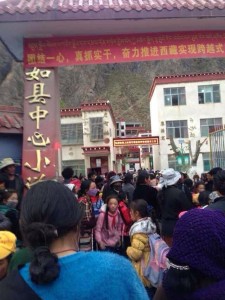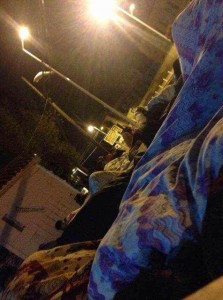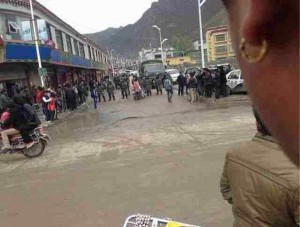Beatings, detention, threats after Tibetans reject China’s ‘Mass Line’ policy in Diru

China’s domestic security forces including the armed police and the army have engaged in beatings, and detention of 40 Tibetans even as local government and party authorities used threats and intimidation tactics to enforce the so-called “mass-line” policy in Diru (Ch: Biru) County in Nagchu (Ch: Naqu) County in Tibet Autonomous Region (TAR).
Touted by the Chinese government as a means to bring the party leadership closer to the needs and concerns of the masses, the reality is the policy is aimed at bringing every Tibetan under the direct surveillance of the party’s human and technological surveillance machinery.

Many of the mass propaganda and surveillance campaigns implemented in TAR since October 2011 are now being grouped under the new president Xi Jinping’s “mass-line” policy. A host of highly-intrusive mass surveillance campaigns such as the “Benefit the Masses, Solidify the Foundation”, “The Grid Management” system, “New Socialist Villages” and the recently-announced “Advanced Joint Household” system are now being implemented in TAR. The official justification behind all these campaigns is that these campaigns would benefit the Tibetans in two ways: by providing long term stability and prosperity. However, upon implementation, the ‘stability maintenance’ measures, which also include punishing those who refuse to comply with the party’s political ideology, have been enforced with merciless force and unchecked power. The ‘prosperity’ part of the campaign, in the form of economic benefits or state handouts, is in fact used unabashedly to blackmail or force defiant Tibetans to comply with China’s ‘stability maintenance’ policy.
On 28 September 2013, a serious confrontation lasting about three hours broke out between armed Chinese security forces and local Tibetans in Mowa Village in Diru County. It was caused due to the mandatory nature of China’s “Nine Must Haves” campaign which requires, among others, every Tibetan family to put the five-starred Chinese flags on their rooftops. Local Tibetans in Mowa had refused to fly Chinese flags on their rooftops, a space traditionally reserved for sacred prayer flags; instead they threw the flags into a nearby river to express their disapproval. Armed police and the military arrived later to rein in the Tibetans. This led to open confrontation between the two sides as Tibetans used sticks and stones to respond to the firing from Chinese security forces. TCHRD cannot immediately verify the claims that police had indeed shot into unarmed Tibetans.
The same day, as news of the crackdown in Mowa spread, about 40 Tibetans from neighbouring villages of Taklha, Baro, Neshod and Taring appealed to local authorities to refrain from using force on Tibetans. But they were beaten up and detained by the Public Security Bureau (PSB) officers.

According to TCHRD sources, local authorities in Diru County have announced punishment for Tibetans who refuse to comply with official diktats. Authorities have issued threats against Tibetan protesters that their children would be expelled from schools; their sick relatives will not receive medical care in hospitals; and they will not be allowed to harvest the coveted Yartsa Gunbu (caterpillar fungus) medicinal plant. Tibet remains one of the most impoverished regions with one the highest infant and maternal mortality rates. Educational and healthcare facilities are scarce with the handful of schools and hospitals owned and controlled by the Chinese government. In a nomadic area like Diru, where the number of former nomads is growing thanks to China’s nomad resettlement policy, an overwhelming majority of former nomads now rely on caterpillar fungus as a major source of income. Last year, authorities in Malho (Ch: Huangnan) Tibetan Autonomous Prefecture (Qinghai Province) used the same intimidation tactic by threatening to cancel state aid to those villages where self-immolation protests occurred, a typical example of China’s collective punishment.
According to sources from inside Tibet, since 10 September 2013, TAR authorities have sent in more than 18,000 Chinese cadres to Diru to intensify the party’s ‘mass line’ policy. These cadres have been conducting ‘patriotic education’ campaigns among local Tibetans, demanding them to pledge their ‘love and gratitude’ for the party and the nation, and to put up the 5-star Chinese flags on their rooftops. The mass campaign to extract political compliance has added fuel to the fire, making the situation more volatile in Diru. The dumping of Chinese flags in Mowa was the logical culmination of the “Nine Must Haves” campaign.
On 28 September 2013, at around 7 pm, soon after the Mowa crackdown and detention of 40 Tibetans, more than 1000 Tibetans staged a 24-hour hunger strike in front of the County government office. The strikers called on the authorities to release the 40 Tibetans and to put a halt to the flag campaign.
That same evening, acting on direct orders from TAR deputy party secretary Wu Yingjie, and TAR Party Committee member and Nagchu Prefecture Party Secretary Dothog, the 40 Tibetans were released. Sources said many of them have sustained serious injuries as they were beaten up with iron batons.
Sources said that on the evening of 29 September 2013, protest erupted among 4,000 students of County Primary and Middle schools after news reached that the authorities had threatened to expel students whose parents had participated in protest against the government. Sources told TCHRD that the County Middle School has been closed indefinitely. In the County Primary School, only 60 students, all children of Chinese government employees, have stayed behind. The rest have left the school although some students have not returned to their homes.
On 2 October 2013, local Tibetans in Diru County again defied the security forces by putting up human blockades along the major highways which have been occupied by the security forces since protest broke out in Mowa. Sources said local Tibetans view the recent campaign as ploy to destroy Tibetan identity. Many in Diru fear a return to the dark years of Cultural Revolution.
All villages in Diru have been brought under the control of the security forces. Restrictions on Mowa, Monchen and Taring villages are exceptionally severe. Six security checkpoints have been set up in Diru. Security forces run regular patrols in villages watching over each family. Since 28 September 2013, more security forces from Lhasa and Shigatse have been sent to Diru. Sources believe that many more unidentified Tibetans might have been detained although no information is available due to total blockade on all communication lines in Diru. On 4 October 2013, sources said mobile phones of many Tibetans were seized and photos of the recent unrest deleted. Some Tibetans complain that their phones have not been returned.
According to sources, last year the authorities failed to make Tibetans fly Chinese flags on their rooftops in Diru. This year, they have asked everyone to comply or face punishment. Diru County has continued to defy official orders. Moreover, four known Tibetans from Diru County have died of self-immolation protests since October 2012, making this part of eastern Tibet a thorn in the eyes of ‘stability maintenance’ officers.
Last month, official Chinese media reported that the Chinese authorities had sent in 60,000 cadres to be permanently stationed in 5459 villages and 1877 monastic institutions in TAR. These cadres will either work as village level party secretary or as ‘work team’ cadres running political education campaigns and espionage activities under another controversial campaign known as “The Six Ones”. The deputy director of TAR People’s Congress, Ma Bizi, said the campaign was “the largest and most extensive coverage” of TAR by grassroots cadres “since the peaceful liberation of Tibet in 1951.”
According to official Chinese media, the “Nine Must Haves” campaign is now being implemented in villages and monastic institutions in TAR. This is in addition to other mass monitoring and surveillance campaign being implemented in TAR under the guise of “stability maintenance” policy. Latest official reports show that The Grid Management system and Advanced Joint Household campaign are successfully being implemented in Lhasa and Shigaste prefectures.
Earlier this year, Human Rights Watch (HRW) reported that the “Benefit the Masses” campaign discriminates against Tibetans” according to their religious and political thinking, and establishing institutions to monitor their behavior and opinions.” Calling the Grid Management system Orwellian, HRW said in a statement that the purpose of the Grid Management “appears to be surveillance and control, and it encroaches on Tibetans’ rights to freedom of expression, belief, and association.”
In May 2013, the TAR authorities announced the implementation of another campaign called the “Advanced Joint Household” under which all Tibetan families or households are divided into small units, each unit consisting of five to 10 households, making it easier for the authorities to monitor and control every member of the household. For instance, in Shetongmon (Ch: Xietongmon) County in Lhasa Prefecture, each unit comprises of 10 households: one household with party members, three rich households, three moderately rich households and three poor households. The presence of a household with party members is obviously aimed at ensuring stability inside the unit. This campaign is the basic level of the Grid Management system, with ‘joint household’ unit leaders or inspectors acting as the foot soldiers of the grid system. On 25 July 2013, the official Tibet Daily quoted Choedak , member of TAR Party Standing Committee and head of TAR United Front Work Department as saying that the ‘advanced joint household’ campaign is aimed at “fighting against the 14 Dalai Lama and other overseas Tibetans, and hostile foreign forces” in Tibetan areas. He said the campaign would stabilize the opinion and thoughts of the masses thus ensuring long term stability. “The Advanced Joint Household campaign should turn into a basic level of the Grid Management system.”
The campaign is being implemented under the joint leadership of five levels of administration: autonomous region, prefecture, county, township and village. Lhasa and Shigatse Prefectures are projected as models for successful implementation of the ‘joint household’ campaign. In Lhasa Prefecture, the authorities have set up 14304 ‘joint household’ units, covering 144263 families and 430185 people. In Shigatse Prefecture, there are 18929 units. The total number of units in TAR stands at 77000, covering 70000 households and about three million people. In 2010, the population of TAR, according to official census, was little over three million.
The campaign is ostensibly designed as a state-organised contest among citizens for periodic ‘advanced joint household member’ awards which carry cash prizes. For instance, in Sakya County in Shigatse Prefecture, cash prizes for each ‘advanced member’ ranges from 1000 to 3000 yuan. But refusal to join the campaign in the face of pressure from thousands of cadres is near impossible for many Tibetans. Chinese state media reported that the reward system would over a time inculcate a sense of voluntary initiative among Tibetans to dispense their ‘stability maintenance’ responsibilities under the campaign. Irrespective of the state media reports, the ‘mass line’ policy has all the makings of a police state. In Rinpo (Ch: Renbu) County in Shigatse, all unit inspectors have been given red armbands, helmets, whistles, flashlights, boots, ID cards.
Recently, Chinese state media reported that in each ‘joint household’ unit, unit inspectors are required to monitor and ‘educate’ a special group of people, such as youngsters, former political prisoners and others with political history. Each household should watch over activities of other households to fight challenges and create social stability, exhorted the state media reports. In particular, each unit should prevent protests and petitioning by a large group of families against the state development projects especially during relocation programs.
Reporting on the successful implementation of the ‘joint household’ campaign in Lhasa, state media quoted local authorities as saying that the campaign played a major role in preventing any protests against the forced relocation program when renovation work began this year in the traditional Tibetan neighborhood in Lhasa city. Many Tibetan shopkeepers and others who have lived there for generations were relocated to government-built houses in the outskirts of Lhasa city. The official Tibet Daily reported that unit inspectors in Lubuk neighborhood in Lhasa city pay extra attention on crowded places such as tea houses to collect information. The unit inspectors in Lhasa’s Kundeling Street maintain constant contact with guards manning “convenience police stations”. Whenever unit inspectors hear about suspicious information, they lose no time in relaying this information to “convenience police stations”. HRW reported that by July 2012, 676 permanent “convenience police-posts” (Ch.: bian minjing wu zhan) had been set up in TAR. These are manned by police officers who are on duty around-the-clock.
Far from benefiting the Tibetans, the mass monitoring and surveillance campaigns seek to control all aspects of Tibetan life with raw, unrestrained state power. No distinction is drawn between individual freedom and so-called national security measures. It will be only a matter of time before China’s ‘mass line’ policy turns Tibet into a police state.
Endnotes
I. ‘The Six Ones’ are:
1. Make one friend. Each temple management official should try to be soulmates with one or several monks/nuns to understand their difficulties in life and what’s going on in their mind. (要交一个朋友。每个驻寺干部都要与一至几名僧尼交成知心朋友,及时了解他们的生活困难和思想动态。)
2. Visit one family. Each temple management official to visit the families of one or more monks/nuns to understand what’s going on in their homes. (开展一次家访。每个驻寺干部都要联系一至几名僧尼,深入自己所联系的僧尼家中搞一次家访,切实了解僧尼家庭的实际情况。)
3. Solve one problem. To solve the most urgent, real problem facing the family of any monk/nun so as to make them feel the warmth of the party and government. (办一件实事。发挥各自优势,为每个僧尼家庭解决一件最迫切、最现实的困难和问题,让他们切身感受到党和政府的温暖。)
4. Build one file. Establish a file for every monk/nun to document in a detailed fashion their personal and family situation. This will aid in preparedness, understanding and management. (建一套档案。为每个僧尼建立一套档案,详细记录其个人信息和家庭状况,切实做到心中有数、底数清楚,便于管理服务。)
5. Keep clear one communication channel. Steady communications should be maintained between temple management officials and the families of monks/nuns through telephone, letters and house visits, so as to educate them to love the nation and love the religion, as well as to obey the law. (畅通一条渠道。通过电话、通信、家访等方式,建立起驻寺干部与僧尼家庭联系的稳定渠道,与其家人共同教育引导僧尼爱国爱教、遵规守法。)
6. Develop one mechanism. To build temple management committees (with full-time officials) that temple management officials, monks/nuns and families are jointly responsible for. This is to develop a mechanism for building harmonious model temples. (形成一套机制。建立起寺庙管委会(专职特派员)、驻寺干部、僧尼、家庭共同负责、协调联动的构建和谐模范寺庙的好机制。)
II. The Nine Must Haves are:
1. Must have portraits of Chinese leaders
2. Must have five-starred Chinese flags
3. Must have roads
4. Must have water
5. Must have electricity
6. Must have radios and TVs [only official channels allowed]
7. Must have communication facilities
8. Must have newspapers [only official newspapers]
9. Must have cultural libraries
Links to media reports cited in this report:
http://news.xinhuanet.com/politics/2010-01/22/content_12858927.htm
http://www.xzali.gov.cn/xzsw/3600.jhtml
http://epaper.chinatibetnews.com/xzrb/html/2013-07/25/content_466887.htm
http://xz.people.com.cn/GB/139198/139214/10956296.html
http://epaper.chinatibetnews.com/xzrb/html/2013-09/06/content_475586.htm
http://www.chinadaily.com.cn/hqgj/jryw/2013-05-29/content_9171058.html
http://www.hrw.org/news/2013/06/18/china-benefit-masses-campaign-surveilling-tibetans
http://www.hrw.org/news/2013/03/20/china-alarming-new-surveillance-security-tibet http://www.hrw.org/news/2013/03/20/china-alarming-new-surveillance-security-tibet
http://www.tibetinfor.com/
http://www.vtibet.cn/
http://www.tibetinfor.com/news/xzxw/szfl/201309/t20130917_1931456.htm


